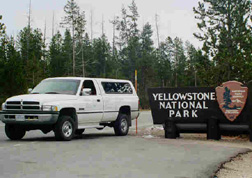Bioenergy
Truck-in-the-Park Demonstrates
Low-Emission, Biodegradable Fuel

In February 1995, Dodge truck Inc.
donated to the project a new 1995 �-ton 4x4 pickup ($30,000 value). Since that
time, the truck, driven by Yellowstone employees, has gone over 100,000 miles
on 100 percent biodiesel. It averages about 17 miles per gallon, the same as when
it was tested with regular diesel fuel during baseline data development. No modifications
were made to the truck's engine or fuel system. The emissions test conducted on
the truck showed that smoke, hydrocarbons, nitrogen oxides and carbon monoxide
were reduced by using the biodiesel. Tests also showed that the sweet odor of
biodiesel exhaust does not attract bears, which was a concern to park managers.
In September 1998, the truck's
engine was completely torn down and analyzed, revealing very little wear and no
carbon build-up. The truck is now in Phase II, in which the intent is to accumulate
200,000 miles over the next three years.
The park developed an extensive
education program for the public. Lectures and information exchanges have occurred
at visitor centers, trailheads, greening conferences, and numerous educational
institutions.
The growing and harvesting of rapeseed,
the oil extraction process, and fuel demonstration are all accomplished within
a tri-state region around Yellowstone. The park will continue to commit to spearhead
projects and partnerships that show regional success.
In addition, all public service
stations in Yellowstone began supplying ethanol blend in September 2000. The project
is part of the greening effort to reduce pollution from all vehicles in Yellowstone
and Grand Teton National Parks. The pollution prevention method will reduce carbon
monoxide (by 20 percent), fine particulate matter (by 36 percent), unburned hydrocarbons
(20 percent) and air toxics (by 22 percent) from all gasoline powered vehicles
operating in Yellowstone, based on a study done by the Colorado School of Mines.
The National Park Service has used ethanol blend (a blend of 10 percent fuel ethanol
and 90 percent unleaded gasoline) year-round in their administrative fleet since
June 1, 1998 without problems.
The "Truck in the Park"
Project was designed with two purposes: to define a market for biodiesel and to
provide data on emissions and performance that could be used by land managers,
regulators, and providers of commercial tourism transportation. This project was
a first-step to reduce environmental impacts resulting from diesel fuel use in
the tourism industry. Basically, the project placed a unaltered diesel pickup
truck into service in Yellowstone National Park, fueled this truck with 100 percent
rapeseed ethyl ester, and monitored performance and emissions. Data were collected
to determine the reliability, benefits, and costs of using biodiesel in Yellowstone
National Park and the surrounding region. The project included fuel characterization,
detailed performance and emissions tests before and after (approximately) 160,000
km (100,000 miles) (using EPA protocols), and other quality control testing to
document benefits and costs. The technical data and results of this demonstration
are being documented in other papers and referred to in this text.
Howard Haines of the Montana Department
of Environmental Quality and Jim Evanoff of the National Parks Service report
about the project in a paper titled Environmental and Regulatory Benefits Derived
from the Truck in the Park Biodiesel Emissions Testing and Demonstration in Yellowstone
National Park (PDF 80KB).
The paper describes the implications of their results for the Yellowstone region
and the challenges of bringing biodiesel fuel technology to market.� � |